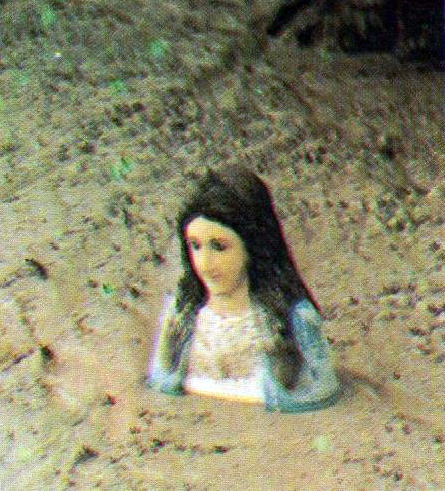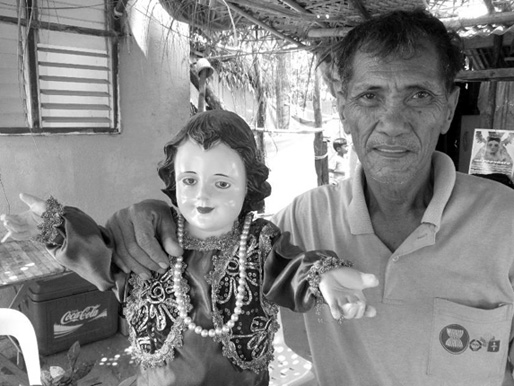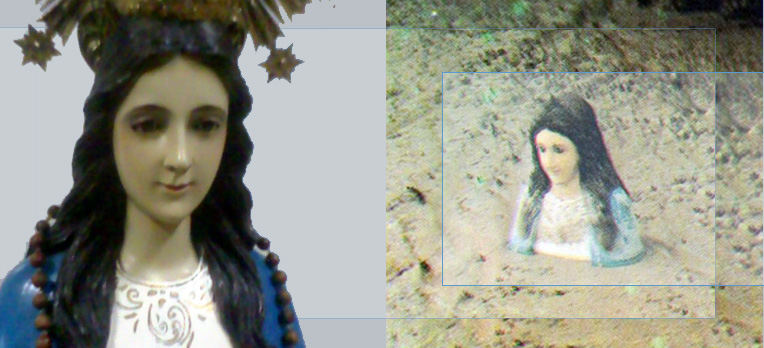by Bernie V. Lopez

The Pinatubo Miracle – A True Story
When Mt. Pinatubo erupted in 1991, Sister Raquel Reodica, RVM, visited their mission house in Poonbato, Botolan, Zambales, Philippines. Her congregation was helping rescue the Aetas. They found the five-foot statue of Ina Poonbato buried in lahar up to the shoulders. They tried to extricate it, digging around the lahar, but it would not budge.
Sister Raquel asked a Colonel if his helicopter could possibly extricate the statue. The colonel said it was impossible to lift a heavy cement statue. Sister Raquel insisted, “Just try, colonel. Nothing to lose.” Finally, he gave in, instructing the pilot to abandon the job if it was too heavy. The helicopter extricated the image with ease. The colonel ran up excitedly to Sr. Raquel, “Sister, it’s a miracle. The pilot says the helicopter weighing scale recorded ‘zero weight’.”
The Mustard Seed
Like the mustard seed in Matthew 13:31, which grew into a giant tree, the devotion to Ina Poonbato had humble ethnic beginnings back in the late 17th century, slowly growing into a national pilgrim center. Sisters Babie Hilario and Joyce Fablos at the Catholic shrine report that in the past few years, pilgrims have soared, coming from as far as Bataan, Ilocos, Metro-Manila, Bulacan, San Pedro and San Isidro in Laguna, and Dasmarinas in Cavite. Sister Babie estimates that in last feast day on January 23-24, 2016, about 12,000 to 14,000 pilgrims converged in Poonbato, based on 14 masses in a single day.
Last March 4, the Mayor of Gumaca in Quezon led dozens of pilgrims to Poonbato. He vowed that, if his son would pass the board exam, he would return as a pilgrim in gratitude. On March 11, he indeed came back. His son passed the board. He brought many replicas of Ina (mother) to Gumaca, spreading the good news to the town. There are many reports from both Catholics and Aglipays of prayers granted ━ the sick being healed, the childless having children.
The mustard seed promises to go global. Many Filipino devotees in the US and EU have replicas of Ina. Perhaps it is because, back in October 1985, Pope John Paul II blest an image brought by the late Rosellyn Magsaysay. She brought the devotion and statues to Filipino communities in her many trips to the US and EU.
Oral History
Franklin Narciso, an Aglipay, is a reported direct descendant of the Aeta chieftain Apang (Chieftain) Djadig, who ‘discovered’ the image of Ina back in the 17 century. Sisters Babie and Flor confirm the story. Franklin is the caretaker of the Aglipay church as of this writing.
Franklin relates in a live interview that there was a drought then, and Djadig, went out to hunt to feed his hungry family. Finding no prey, he slept under a tree with huge rocks underneath it (hence Poonbato, meaning ‘tree stone’). He was awakened by the voice of a lady who said, “Do not to be afraid. Go to the side of a mountain. If you catch a deer, come back to me.” (According to a Catholic document, the lady simply said, “Take me home with you.”)
Djadig obeyed. When he came back to the tree, there was an elegant wooden statue of the lady, which he brought home, forgetting about the deer in his excitement. His wife was angry because he failed to bring home food. She threw the statue into a fire, and the house was burnt to the ground, but the statue was not. Instantly, the wife had a lingering skin disease, and when she caressed the image of Ina, she was healed. Apang Djadig built a hut for Ina and announced to his tribe that she had healing powers. True enough, many were healed. They held an annual feast for Ina, their healer.

When the Spanish Augustinian Recolletos arrived in 1736, they took the statue and named it Nuestra Senora de la Paz y Buenviaje, (Our Lady of Peace and Good Voyage). The Aetas killed the priests and retrieved the statue. The Recolletos made a replica of cement, which reportedly was the same statue Sr. Raquel retrieved from the lahar, and which reportedly stands today in a grotto behind the Catholic church. Then the story gets blurred how the devotion proliferated through the centuries.
There was no competition between Aglipays and Catholics. They shared the same church and took turns in their rituals. The Catholics later built its own present-day shrine. Today, pilgrims visit both Aglipay and Catholic churches, symbol of Marian ecumenism. Today, Ina is the Mother of Aglipays and Catholics, of Aetas or non-Aetas. Like Our Lady of Guadalupe in Mexico, Our Lady of Peace and Good Voyage is of ethnic origin.
━ eastwindreplyctr@gmail.com
